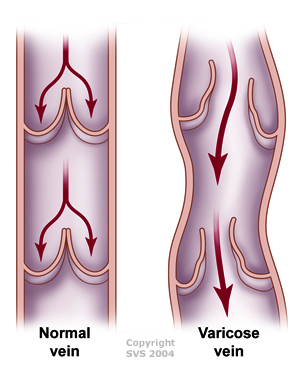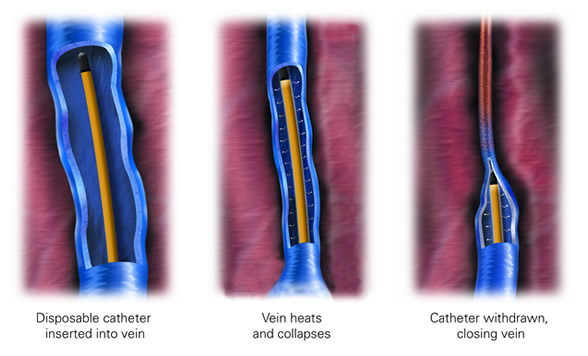Saphenous Vein Ablation | Varicose Vein Treaments Austin, TX
Saphenous Vein Ablation | Austin, TX
Austin Vascular Surgeons are experts in the treatment of peripheral venous disease. One of the most common forms of venous disease is saphenous vein reflux disease. Saphenous vein reflux disease occurs when the valves inside the superficial veins of the legs become defective. The defective valves in the legs lead to the vein flow in the legs reversing direction. This is referred to as valve reflux, ie saphenous vein reflux. Saphenous vein ablation is a cure for this condition.
Saphenous Vein Reflux and Varicose Veins
 The resultant abnormal pressure build-up that occurs in the legs with saphenous vein reflux leads to varicose veins forming on the legs, ankles, or feet. The pressure can also lead to symptoms of leg pain, leg fatigue, leg or ankle swelling, and skin changes of the ankles and feet. The skin changes can include dermatitis, pigmentation, or ulcers. The skin changes are often accompanied by enlarging varicose veins on the legs. Other patients with saphenous vein reflux do not have visible varicose veins but can exhibit the other leg symptoms described. Saphenous vein reflux is a progresive disease that worsens with time.
The resultant abnormal pressure build-up that occurs in the legs with saphenous vein reflux leads to varicose veins forming on the legs, ankles, or feet. The pressure can also lead to symptoms of leg pain, leg fatigue, leg or ankle swelling, and skin changes of the ankles and feet. The skin changes can include dermatitis, pigmentation, or ulcers. The skin changes are often accompanied by enlarging varicose veins on the legs. Other patients with saphenous vein reflux do not have visible varicose veins but can exhibit the other leg symptoms described. Saphenous vein reflux is a progresive disease that worsens with time.
Diagnosis of Saphenous Vein Reflux
Saphenous vein reflux is diagnosed by a combination of physical examination and a venous ultrasound called a venous reflux ultrasound. Ultrasounds are also referred to as duplex studies or doppler studies. The ultrasound technician performing the venous duplex needs to be properly trainined in venous reflux testing in order for the studies to be accurate. The venous reflux ultrasound should also be performed in the standing position to be accurate. Saphenous vein reflux can involve one saphenous veins or multiple saphenous veins. The vein reflux is gauged as mild, moderate, or severe. The most common saphenous vein that develops venous reflux is the great saphenous vein.
Treatment of Saphenous Reflux – Saphenous Vein Ablation
Saphenous Vein Ablation is indicated to treat signfificant cases of saphenous vein reflux that are leading to the development of enlarging varicose veins, leg pain, leg swelling, leg fatigue, skin pigmentation, or other chronic leg symptoms. Vein ablation is also performed to treat saphenous reflux that has leg to leg complications such as blood clots, vein ulcers of the ankles / feet, or bleeding from the skin.
Saphenous vein ablation can cure saphenous vein reflux and varicose veins. The ablation can also resolve all of the symptoms that occur in the legs, ankles, and feet. There are several different methods of saphenous vein ablation that vary based on the underlying saphenous anatomy.
Methods of Saphenous Vein Ablation
 EndoVenous Laser Ablation (ie EVLT)
EndoVenous Laser Ablation (ie EVLT)
A thermal ablation method to close an abnormal leg vein by inserting a laser fiber into a leg IV. Performed with local anesthesia.
ClosureFast Radiofrequency Ablation
A thermal ablation method to close an abnormal leg vein by inserting a radiofreqequency fiber into a leg IV.Performed with local anesthesia.
Varithena Endovenous Chemical Ablation
A liquid medication is infused into an abnormal leg vein by ultrasound guided IV placement. The medication causes the vein to collapse and disappear. Performed with local anesthesia.
VenaSeal Medical Super Glue Ablation
A medical glue is inserted into the abnormal vein to cause the abnormal vein to seal close. Performed with local anesthesia.
Clarivein Mechanical-Chemical Ablation
A device that is inserted into the saphenous vein through a small IV catheter. The catheter contacts the inside lining of the saphenous vein and delivers a sealing medication into the wall of the vein, causing the vein to collapse and close. Performed with local anesthesia.
Surgical Stripping Saphenous Ablation
The traditional way of resolving abnormal veins by surgical removal of the veins by small skin incisions on the legs. This vein surgery is performed under anesthesia in an operating room.






